How to Communicate Compensation Changes Effectively
Navigate compensation change successfully. Implement clear plans, craft concise messages, and engage leaders. Encourage transparency today!
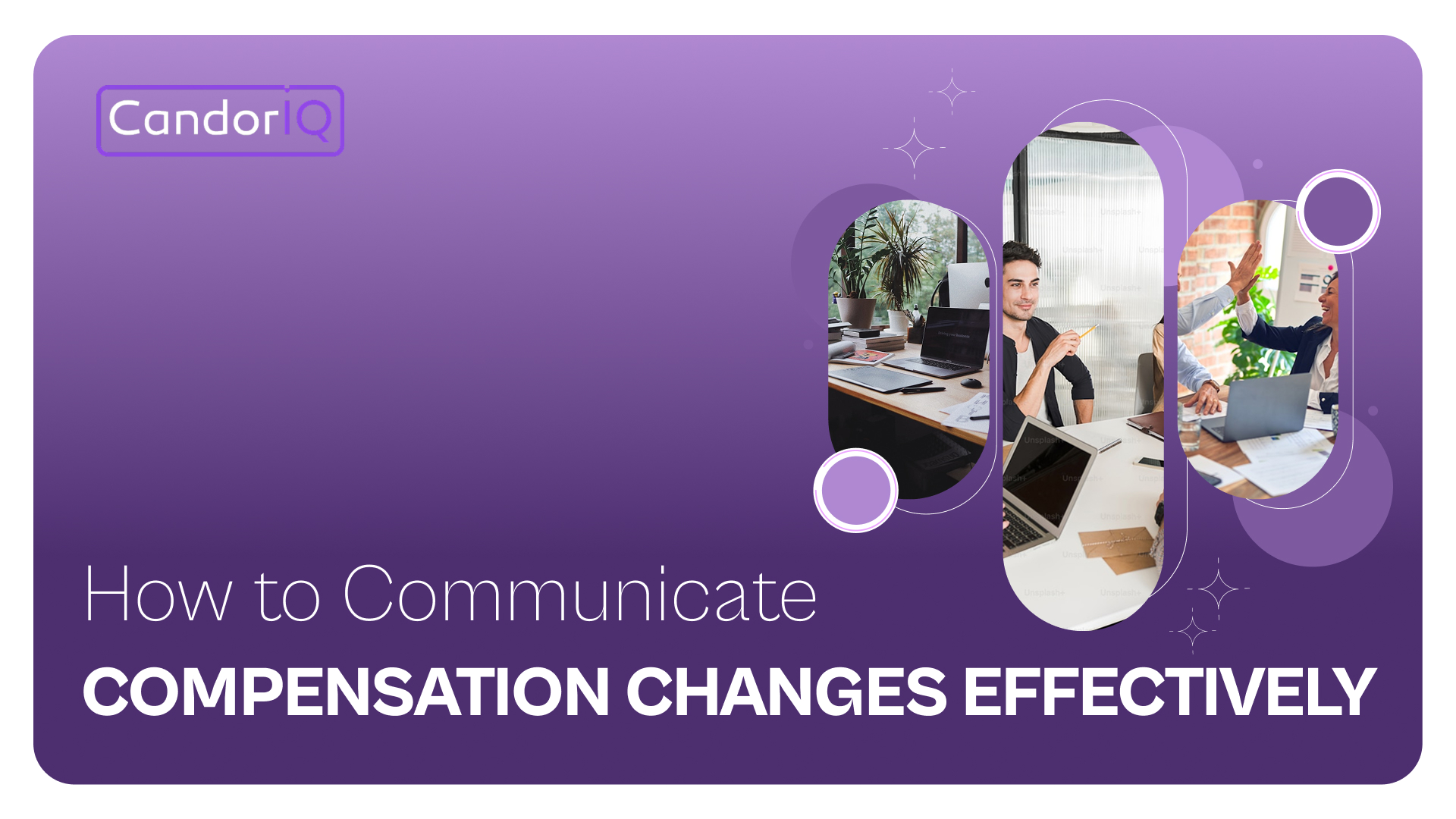
Imagine if airlines changed your seat mid-flight without telling you. You would be confused, anxious, maybe even angry. That is what compensation changes feel like to employees when they are delivered poorly. And in fast-moving companies, the ripple effect spreads quickly from Slack channels to Glassdoor reviews.
In a world where salary data is public, expectations around fairness are high, and remote teams crave clarity, how you communicate pay decisions is as important as what those decisions are. Yet many organizations still treat compensation updates as administrative tasks instead of strategic conversations that shape culture, retention, and trust.
This guide is built for modern HR and Finance teams who want to get it right. Whether you are managing merit cycles, rolling out equity refreshes, or adjusting salaries based on market shifts, we will break down how to design communication that is clear, timely, and aligned with your company’s values.
TL;DR
- Poorly communicated compensation changes create anxiety and mistrust, especially in fast-moving organizations
- Clarity on the business, market, and individual drivers behind pay changes is critical before making announcements
- Internal alignment between HR, Finance, Legal, and leadership avoids conflicting messages
- The timing and sequencing of communication should be planned to avoid leaks, confusion, or emotional backlash
- A multi-channel approach that includes live sessions, written notes, and manager check-ins helps ensure transparency
- Clear, empathetic messaging makes compensation updates feel intentional, not transactional

Understand the Why Before You Explain the What
Employees are more receptive to change when they understand the reasoning behind it. Yet, this foundational step is often rushed or overlooked.
Before drafting any announcement or prepping managers, leadership needs internal clarity. Not just on the numbers, but on the rationale that connects those numbers to the company’s current priorities and values.
Here’s what needs to be mapped out clearly:
- Business context: Was this decision driven by revenue performance, cost control, or a shift in strategic direction? Even high-performers want to know how company performance affects personal compensation.
- Individual or role-based drivers: Is the change tied to a new scope of work, updated leveling frameworks, or internal benchmarking? Employees will want to see how their role evolution connects to new pay decisions.
- External market influence: Has there been a recent benchmarking exercise? Are pay bands being realigned due to market competitiveness or geography-based normalization?
- Retention or equity strategy: If adjustments are being made to retain top talent or refresh equity, clarify how these moves support long-term engagement goals.
- Equity and fairness lens: Explain whether this round of changes includes pay equity audits, DEI-related adjustments, or gender gap corrections. Transparency here builds lasting credibility.
This clarity should not stay in the boardroom. It needs to filter into your talking points, manager FAQs, and employee conversations. Because when employees can connect the dots between business logic and personal impact, the message lands with more trust and less noise.
Align Internally Before You Speak Publicly
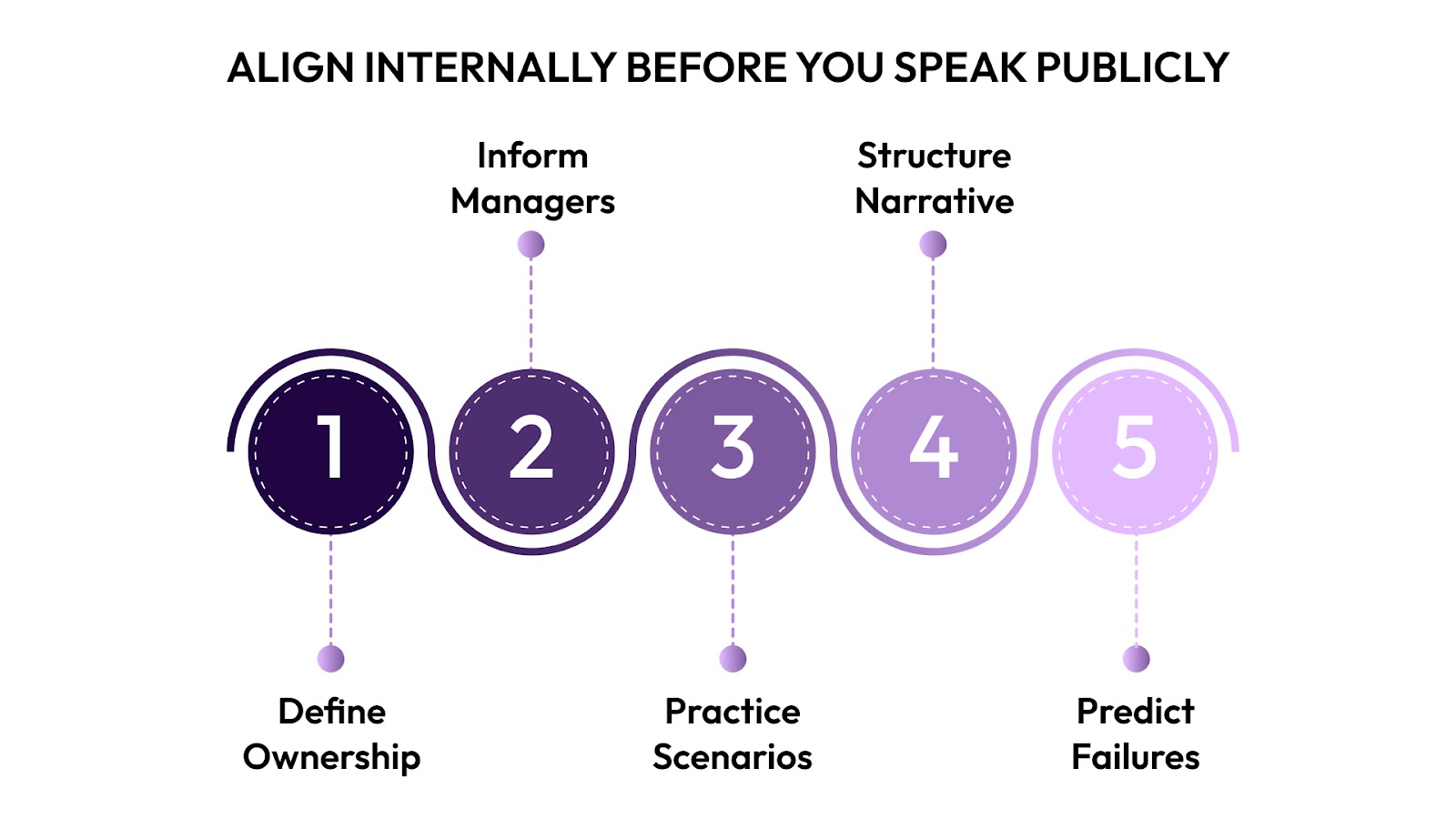
Compensation changes often fail not because of the message, but because of misalignment within the company. When HR, Finance, and leadership are not on the same page, even well-intentioned announcements create confusion, misinterpretation, or worse, mistrust.
Before anything is communicated externally, internal alignment must be treated as non-negotiable. Here’s how to prepare the ground:
- Clarify ownership across departments: Who signs off on the numbers? Who manages the narrative? Who ensures compliance? Create a clear division of responsibilities across HR, Finance, Legal, and Communications. This avoids last-minute edits and conflicting information.
- Brief people managers early: Your managers are not just recipients of the update. They are the first line of response for employee questions. Equip them with a manager toolkit that includes context, FAQs, talking points, and escalation channels. If managers sound uncertain or inconsistent, the credibility of the change drops instantly.
- Rehearse sensitive scenarios: Not every employee will be thrilled with the outcome. Prepare leadership and managers to handle tough conversations around missed raises, perceived unfairness, or timing questions. Practicing how to respond with empathy, data, and clarity can reduce emotional fallout.
- Decide the narrative structure: Start outlining what will be shared and how. Will you lead with context or numbers? Are there visual aids that make your rationale clearer? Think of this as a campaign, not just a memo. Every word, tone, and delivery format should reflect your company’s values.
- Anticipate where things can break: Run through worst-case communication scenarios. What if a spreadsheet leaks? What if a high performer gets overlooked? Build contingencies into your rollout plan so you can act quickly and minimize disruption.
By taking the time to align behind the scenes, you set the stage for a message that feels intentional and unified. The result is not just better communication, but higher confidence across the company.
Timing Makes a Difference

Even well-crafted compensation updates can fall flat if shared at the wrong moment. Timing is not just a logistics issue. It signals intent, respect, and strategic awareness.
When done thoughtfully, timing helps employees receive the message with context, clarity, and calm. Rushed or delayed announcements, on the other hand, can stir confusion or frustration.
Here’s how to get the sequencing right:
- Pick the moment with care: Avoid periods of uncertainty, high workload, or major transitions. The best time is when teams are stable enough to process the message and have space to ask questions.
- Start with leadership, then cascade down: Share the plan with executive leadership first, then brief people managers. Only after this alignment should you roll out the update company-wide. This layered approach avoids surprises and ensures consistent answers across the board.
- Give managers a head start: Allow at least 24 to 48 hours between briefing managers and informing teams. This buffer helps them prepare, internalize the details, and tailor responses based on individual team dynamics.
- Anticipate cross-talk between teams: In hybrid or remote setups, updates travel fast through backchannels. Ensure that your timing across regions or departments is tight enough to prevent confusion but staggered enough for tailored delivery.
- Support it with follow-through: Plan your communication not as a one-time announcement but as a sequence. The initial message should be followed by manager check-ins, town halls, Q and A sessions, or one-on-ones depending on the scope of change.
A well-timed communication shows that leadership is in control and values employee experience. It sets the tone not just for how people feel about the pay change, but how they perceive leadership as a whole.
Not sure how timing affects perception? Use CandorIQ to plan your comp cycle timelines in advance, track decision status, and coordinate communication rollout across regions and departments.
Match Message to Medium
How you communicate compensation changes is just as important as when and what you communicate. The wrong medium can create misunderstandings, stir anxiety, or feel impersonal. The right one helps employees feel respected, informed, and heard.
Rather than defaulting to a mass email or a Slack update, consider the nature of the message and how it’s likely to land.
- Use layered communication: Relying on one channel is rarely enough. Combine written, verbal, and live formats to ensure clarity and retention. A thoughtful email sets the baseline. A manager conversation reinforces context. A town hall allows open discussion.
- Match format to sensitivity: For larger org-wide adjustments like merit cycles or equity refreshes, an email from leadership followed by team meetings works well. For sensitive or individual changes, a direct conversation is more appropriate than written formats.
- Equip managers with toolkits: Managers are often the first line of follow-up. Give them talking points, FAQs, and guidelines so they are not improvising answers. Their tone and clarity can shape employee perception more than the official memo.
- Account for remote and global teams: In distributed teams, access matters. Ensure all formats are mobile-friendly, time-zone inclusive, and translated if needed. For example, record town halls for async viewing and provide summary notes afterward.
- Create space for interaction: One-way announcements don’t allow for nuance. Offer channels where employees can ask questions safely, like anonymous Q and A forms, live AMAs, or open-door office hours. Transparency is not just about sharing; it’s about inviting dialogue.
Choosing the right delivery method doesn’t just improve understanding. It builds confidence. And in moments of change, that’s one of the most valuable outcomes you can achieve.
Want to give managers exactly what they need to say? CandorIQ auto-generates manager-specific summaries and talking points based on recent pay history, performance, and benchmarks, making every conversation easier and more accurate.
Craft the Message with Care
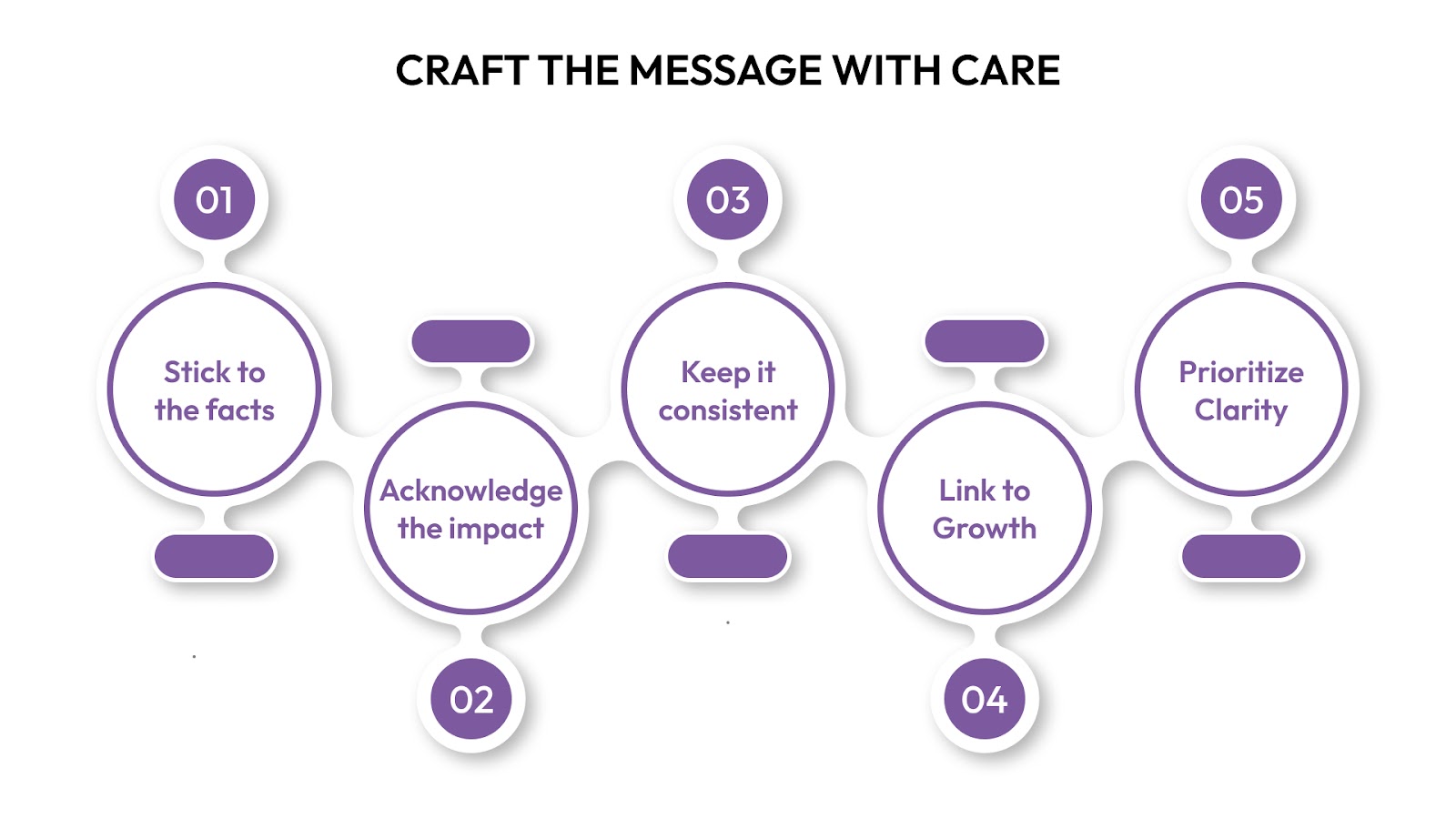
Compensation updates sit at the intersection of numbers, emotions, and expectations. The words you choose can reinforce trust or create unnecessary friction. So how you frame the message matters just as much as the actual change being conveyed.
- Stick to the facts: Employees don’t want vague justifications or feel-good statements. They want to understand what changed, why it changed, and how it affects them. Be concise. Use plain language. Avoid jargon or overly technical terms that confuse rather than clarify.
- Acknowledge the impact: Even positive changes can raise questions. A new salary might bring up concerns about equity or future expectations. Instead of brushing past these, acknowledge them openly. It shows awareness and empathy.
- Keep it consistent: Whether the update is shared in an email, discussed in a one-on-one, or presented in a company-wide meeting, the core message should not vary. Inconsistent messaging across departments breeds confusion and frustration.
- Show the connection to growth: If a change reflects improved performance, market realignment, or internal milestones, say so. Linking it to a broader narrative gives employees context and helps them see where they fit in the company’s trajectory.
- Don’t write for approval, write for clarity: This isn’t the time for corporate-speak. The goal is not to impress, but to inform. Keep sentences short. Prioritize clarity over perfection. If it sounds better in conversation than it reads in a memo, it’s probably the right tone.
When done well, a clear and grounded message does more than just inform. It helps employees feel respected, trusted, and valued in the moments that matter most.
Prepare Managers to Lead Meaningful Conversations
Managers are often the first point of contact when compensation updates are shared. How they communicate the message can directly shape how employees feel about it. A poorly handled conversation can undo hours of planning, while a thoughtful one can build trust and clarity.
Here’s how to help your managers prepare for those crucial moments:
- Train with context: Managers need to understand the why behind the changes, not just the what. Equip them with talking points that go beyond surface-level data and reflect the company’s goals, values, and intent.
- Anticipate tough questions: Not every conversation will be easy. Some employees may question fairness, timing, or rationale. Walk managers through possible scenarios and provide sample responses that balance empathy with clarity.
- Provide room for dialogue: Encourage managers to create space for employees to express their thoughts. This is not a one-way announcement. A two-way discussion builds confidence and helps uncover areas where further clarity may be needed.
- Follow up after the announcement: Support does not end once the message is shared. Ask managers to check in with team members after a few days to answer lingering questions, address concerns, and reinforce key messages.
- Encourage manager feedback too: Managers are closest to how teams are reacting. Give them an easy channel to share insights back to HR or leadership. This can help improve communication strategies in future cycles.
Strong communication starts with strong preparation. When managers feel confident and equipped, employees feel more informed and supported; no matter the nature of the update.
Addressing Employee Questions and Concerns
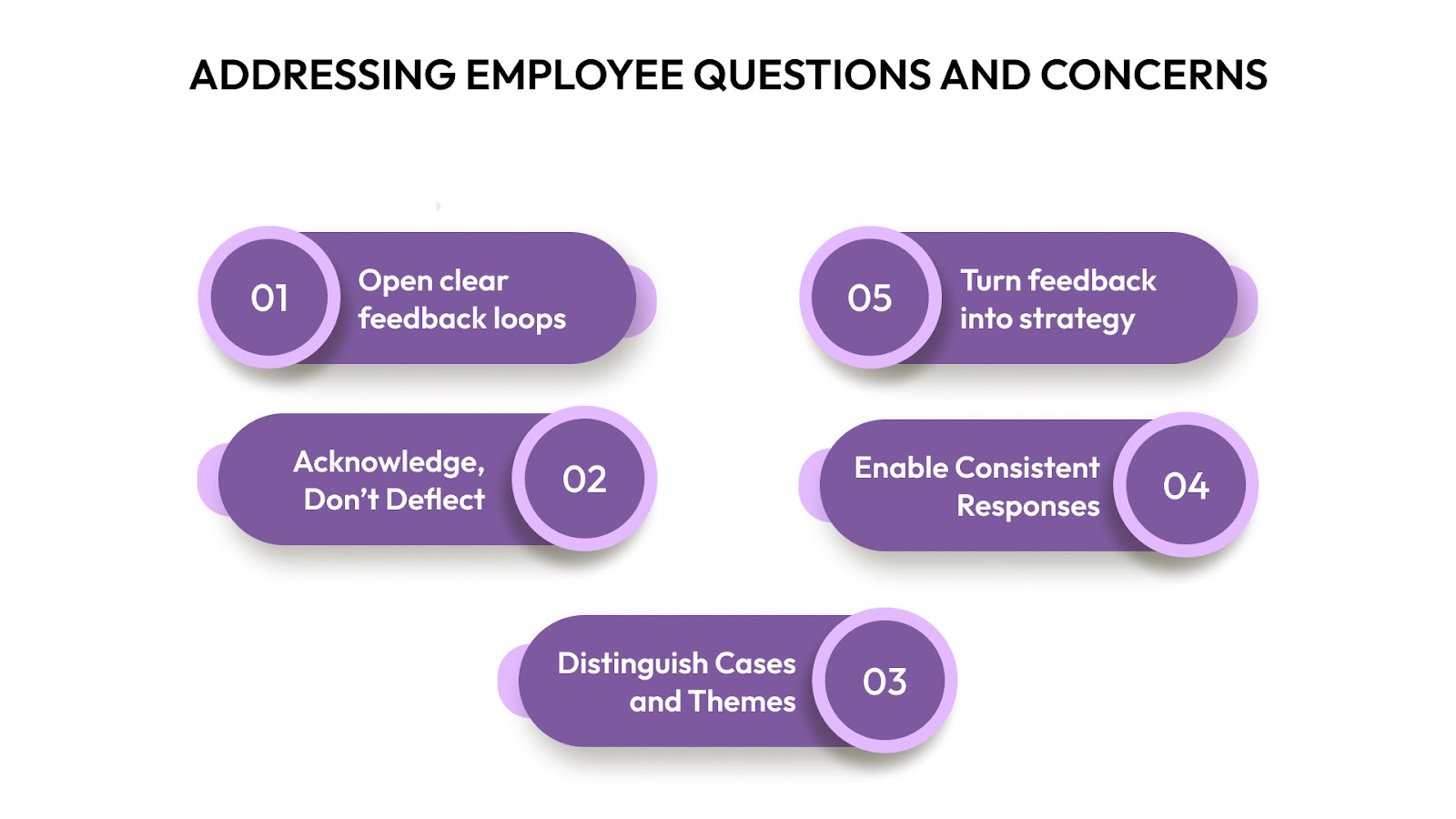
Even the most well-planned compensation communication can face resistance. Employees may feel disappointed, confused, or even undervalued. The goal is not to eliminate pushback entirely, but to create a space where it can be voiced, heard, and addressed constructively.
Here’s how to navigate that process:
- Open clear feedback loops: Provide multiple avenues for employees to ask questions or raise concerns. Anonymous forms, scheduled office hours, and manager-led team huddles offer safe spaces for honest feedback.
- Acknowledge the discomfort, don’t deflect: It’s natural for people to compare outcomes or question fairness. Instead of sidestepping difficult conversations, validate the emotions involved and explain how the decisions were made, without sounding defensive.
- Separate individual cases from systemic themes: Not all concerns require policy changes. But if the same issue is surfacing across teams, like confusion around performance criteria or market benchmarking; flag it for leadership and consider it in the next cycle.
- Equip managers to respond consistently: Once feedback begins flowing in, managers need aligned responses. Keep updating manager FAQs and talking points based on common questions. This prevents message dilution and reduces misinformation.
- Turn feedback into strategy: Track the types of questions being asked. Are people confused about equity? Are they questioning how their performance was evaluated? These signals can guide future improvements in documentation, communication, and process.
Employees do not need to agree with every decision, but they do want to be heard and respected. Handling pushback well is not a sign of failure; it’s a sign your culture supports open dialogue.
Worried about handling pushback or repeated concerns? CandorIQ lets you track common employee questions post-announcement and analyze trends; so your team can continuously improve its comp strategy and close information gaps.
How CandorIQ Helps You Communicate Compensation Changes Better
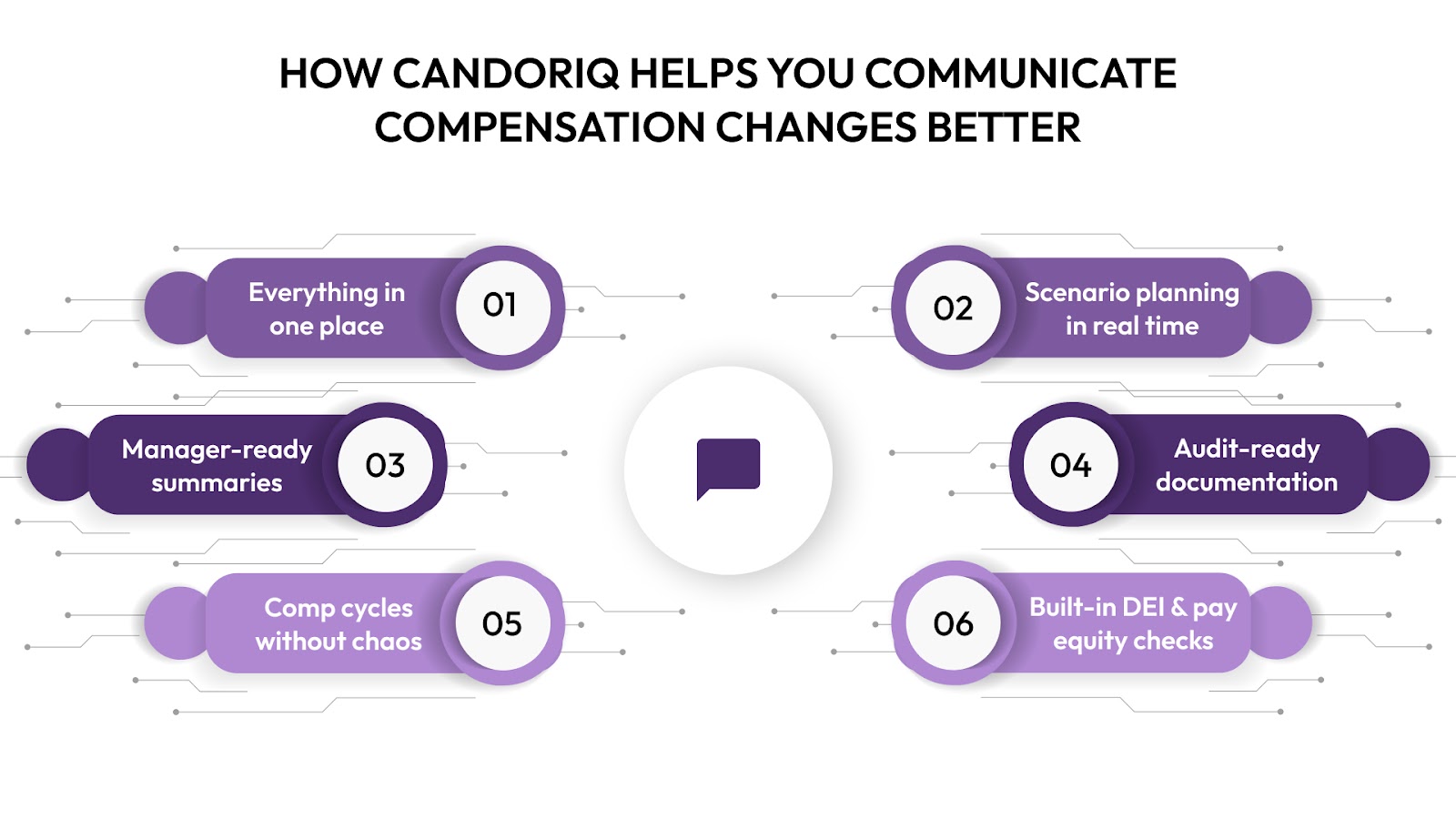
CandorIQ is built for modern HR and Finance teams that want to remove guesswork from compensation conversations. It turns complex data into clear insights, making communication more consistent, transparent, and aligned with business goals.
Here is how CandorIQ makes a difference:
- Everything in one place: CandorIQ centralizes compensation data, performance reviews, leveling frameworks, equity plans, and market benchmarks. No more switching between spreadsheets and internal tools to find the information you need before a conversation.
- Scenario planning in real time: Need to model the impact of a 7 percent raise instead of 5 percent across teams? CandorIQ lets you simulate and compare multiple scenarios before making a final call. You can see how changes affect budget, equity, internal parity, and pay gaps before anything is announced.
- Manager-ready summaries: Managers are often the face of tough conversations. CandorIQ gives them access to customized dashboards that show team-level and individual comp data, recent adjustments, and talking points. This ensures consistency across departments without overloading managers with raw numbers.
- Audit-ready documentation: Every change tracked in CandorIQ is automatically logged with approvals and notes. So if someone asks why a change was made six months ago, the answer is already there. This helps you maintain transparency while keeping your processes clean and defensible.
- Comp cycles without chaos: Whether you are running merit increases, equity refreshes, or executive comp adjustments, CandorIQ gives you a single dashboard to track progress, approvals, communication rollouts, and feedback loops.
- Built-in DEI and pay equity checks: You can run live analyses on gender pay gaps, leveling inconsistencies, or department-wide equity splits before finalizing changes. That means fewer blind spots and more confident decisions.
Want to see how it works in real time? Book a personalized demo of CandorIQ and discover how it can simplify your next compensation cycle; from internal alignment to final delivery.
Final Thoughts
Compensation changes are more than just numbers. They reflect your company’s intent, culture, and priorities. How those changes are communicated can either build trust or quietly erode it over time.
A clear, thoughtful approach shows employees that leadership is aware, empathetic, and prepared. It signals that the company sees them as people, not just payroll entries.
If your organization is growing fast or making complex adjustments, the margin for communication error gets smaller. That is where a system like CandorIQ can help you stay ahead; by bringing clarity to compensation data and making it easier to share that clarity with others.
Ready to move beyond reactive pay updates? Explore how CandorIQ supports confident compensation conversations.

FAQ
Q: What is the best way to explain a salary change to an employee?
Ans: Be direct, clear, and empathetic. Explain the reason behind the change, how it was decided, and what it means for the employee moving forward. Avoid jargon and offer space for questions.
Q: Should salary adjustments be announced privately or publicly?
Ans: Individual changes should always be communicated privately. Organization-wide updates, like merit cycles or cost-of-living adjustments, can be shared in company-wide forums but should never disclose personal compensation.
Q: How do you handle employee disappointment after a pay decision?
Ans: Acknowledge their feelings, provide data or context, and reinforce the connection between pay, performance, and company priorities. Equip managers with scripts or FAQs to maintain consistency.
Q: When is the right time to talk about compensation changes?
Ans: Align announcements with business cycles such as performance reviews or fiscal planning. Avoid periods of high stress or instability. Always inform managers before employees.
Q: Can salary changes affect team morale?
Ans: Yes. Even positive changes can raise concerns about fairness. Clear communication, consistent logic, and opportunities for dialogue help maintain trust across the team.
Q: Should compensation changes be tied to performance reviews?
Ans: In most cases, yes. When performance and compensation are linked, it reinforces accountability and growth. Just ensure the performance data is up-to-date and transparent.


